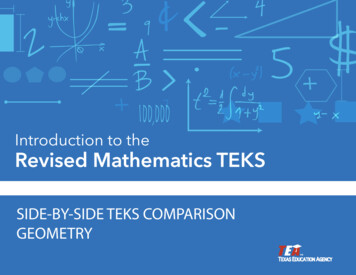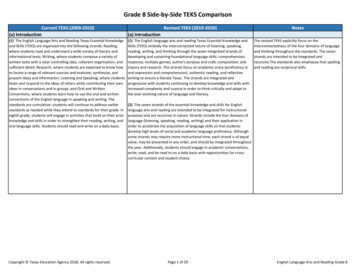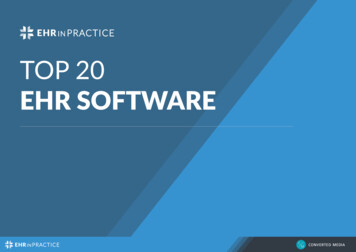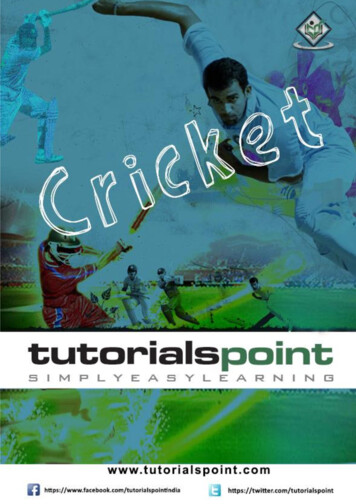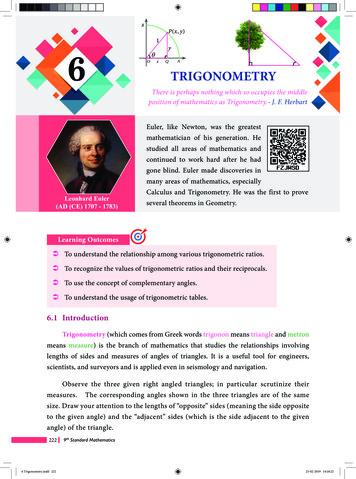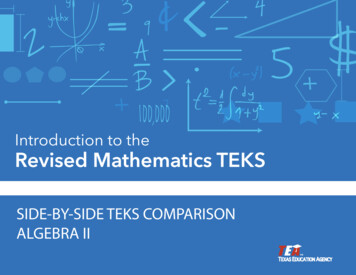
Transcription
SIDE-BY-SIDE TEKS COMPARISONALGEBRA II
The materials are copyrighted (c) and trademarked (tm) as the property of the Texas Education Agency (TEA) and may not be reproducedwithout the express written permission of TEA, except under the following conditions: Texas public school districts, charter schools, and Education Service Centers may reproduce and use copies of the Materialsand Related Materials for the districts’ and schools’ educational use without obtaining permission from TEA. Residents of the state of Texas may reproduce and use copies of the Materials and Related Materials for individual personal useonly without obtaining written permission of TEA. Any portion reproduced must be reproduced in its entirety and remain unedited, unaltered and unchanged in any way. No monetary charge can be made for the reproduced materials or any document containing them; however, a reasonablecharge to cover only the cost of reproduction and distribution may be charged.Private entities or persons located in Texas that are not Texas public school districts, Texas Education Service Centers, or Texas charterschools or any entity, whether public or private, educational or non-educational, located outside the state of Texas MUST obtain writtenapproval from TEA and will be required to enter into a license agreement that may involve the payment of a licensing fee or a royalty.For information contact:Office of Copyrights, Trademarks, License Agreements, and Royalties,Texas Education Agency,1701 N. Congress Ave., Austin, TX 78701-1494;phone: 512-463-9270 or 512-463-9437;email: copyrights@tea.state.tx.us. 2014 Texas Education Agency All Rights Reserved 2014. 2014 Texas Education Agency. All Rights Reserved 2014.Introduction to the Revised Mathematics TEKS: Side-By-Side TEKS Comparison
Algebra II – MathematicsOld TEKSCurrent TEKS (2012)Supporting InformationGeneral requirements. Students shall beawarded one-half to one credit forsuccessful completion of this course.Prerequisite: Algebra I.(b) Introduction.(1) The desire to achieve educationalexcellence is the driving force behind theTexas essential knowledge and skills formathematics, guided by the college andcareer readiness standards. By embeddingstatistics, probability, and finance, whilefocusing on fluency and solidunderstanding, Texas will lead the way inmathematics education and prepare allTexas students for the challenges they willface in the 21st century.Notes(a)A well-balanced mathematics curriculumincludes the College and Career ReadinessStandards.A focus on mathematical fluency and solidunderstanding allows for rich exploration of thekey ideas of Algebra II.Content that is deleted by 2012 TEKS – Content that remains or is clarified in 2012 TEKS ( 2014 Texas Education Agency. All Rights Reserved 2014. Stay) ( Addition) ( Deletion) Content that is new in 2012 TEKS Introduction to the Revised Mathematics TEKS: Side-by-Side TEKS Comparison1
Algebra II – MathematicsOld TEKS(a)(a)(a)Current TEKS (2012)Supporting InformationNotesBasic understandings.(1) Foundation concepts for high schoolmathematics. As presented in Grades K-8, thebasic understandings of number, operation,and quantitative reasoning; patterns,relationships, and algebraic thinking;geometry; measurement; and probability andstatistics are essential foundations for all workin high school mathematics. Studentscontinue to build on this foundation as theyexpand their understanding through othermathematical experiences.Basic understandings.(2) Algebraic thinking and symbolicreasoning. Symbolic reasoning plays acritical role in algebra; symbols providepowerful ways to represent mathematicalsituations and to express generalizations.Students study algebraic concepts and therelationships among them to betterunderstand the structure of algebra.Basic understandings.(3) Functions, equations, and theirrelationship. The study of functions,equations, and their relationship is central toall of mathematics. Students perceivefunctions and equations as means foranalyzing and understanding a broad varietyof relationships and as a useful tool forexpressing generalizations.(a)Basic understandings.(4) Relationship between algebra andgeometry. Equations and functions arealgebraic tools that can be used to representgeometric curves and figures; similarly,geometric figures can illustrate algebraicrelationships. Students perceive theconnections between algebra and geometryand use the tools of one to help solveproblems in the other.(a)Basic understandings.(5) Tools for algebraic thinking. Techniquesfor working with functions and equations areessential in understanding underlyingrelationships. Students use a variety ofrepresentations (concrete, pictorial,numerical, symbolic, graphical, and verbal),tools, and technology (including, but notlimited to, calculators with graphingcapabilities, data collection devices, andcomputers) to model mathematicalsituations to solve meaningful problems.(b) Introduction.(3) In Algebra II, students build on theknowledge and skills for mathematics inKindergarten-Grade 8 and Algebra I.Students will broaden their knowledgeof quadratic functions, exponentialfunctions, and systems of equations.Students will study logarithmic, squareroot, cubic, cube root, absolute value,rational functions, and their relatedequations. Students will connectfunctions to their inverses andassociated equations and solutions inboth mathematical and real-worldsituations. In addition, students willextend their knowledge of data analysisand numeric and algebraic methods.The Revised TEKS (2012) condense thelanguage of the basic understandings.Content that is deleted by 2012 TEKS – Content that remains or is clarified in 2012 TEKS ( 2014 Texas Education Agency. All Rights Reserved 2014. Stay) ( Addition) ( Deletion) Content that is new in 2012 TEKS Introduction to the Revised Mathematics TEKS: Side-by-Side TEKS Comparison2
Algebra II – MathematicsOld TEKSCurrent TEKS (2012)(b)(a)Basic understandings.(6) Underlying mathematical processes.Many processes underlie all content areas inmathematics. As they do mathematics,students continually use problem-solving,language and communication, and reasoning(justification and proof) to make connectionswithin and outside mathematics. Studentsalso use multiple representations,technology, applications and modeling, andnumerical fluency in problem-solvingcontexts.(4)Supporting InformationIntroduction.(2) The process standards describeways in which students are expected toengage in the content. The placementof the process standards at thebeginning of the knowledge and skillslisted for each grade and course isintentional. The process standardsweave the other knowledge and skillstogether so that students may besuccessful problem solvers and usemathematics efficiently and effectivelyin daily life. The process standards areintegrated at every grade level andcourse. When possible, students willapply mathematics to problems arisingin everyday life, society, and theworkplace. Students will use a problemsolving model that incorporatesanalyzing given information,formulating a plan or strategy,determining a solution, justifying thesolution, and evaluating the problemsolving process and the reasonablenessof the solution. Students will selectappropriate tools such as real objects,manipulatives, paper and pencil, andtechnology and techniques such asmental math, estimation, and numbersense to solve problems. Students willeffectively communicate mathematicalideas, reasoning, and their implicationsusing multiple representations such assymbols, diagrams, graphs, andlanguage. Students will usemathematical relationships to generatesolutions and make connections andpredictions. Students will analyzemathematical relationships to connectand communicate mathematical ideas.Students will display, explain, or justifymathematical ideas and argumentsusing precise mathematical language inwritten or oral communication.The 2012 paragraph occurs second in theRevised TEKS (2012), preceding the contentdescriptions. This highlights the emphasis ofstudent use of the mathematical processstandards to acquire and demonstratemathematical understanding.Statements that contain the word"including" reference content that mustbe mastered, while those containing thephrase "such as" are intended aspossible illustrative examples.The State Board of Education approved theretention of some “such as” statements withinthe TEKS where needed for clarification ofcontent.Content that is deleted by 2012 TEKS – Content that remains or is clarified in 2012 TEKS ( 2014 Texas Education Agency. All Rights Reserved 2014.Notes Stay) ( Addition) ( Deletion) Content that is new in 2012 TEKS Introduction to the Revised Mathematics TEKS: Side-by-Side TEKS Comparison3
Algebra II – MathematicsOld TEKS: Foundations for functions 2A(1)(A) Foundations for functions. Thestudent uses properties and attributes offunctions and applies functions to problemsituations.The student is expected to identify themathematical domains and ranges offunctions and determine reasonabledomain and range values for continuousand discrete situations.Current TEKS (2012)Supporting InformationThe revised SE builds onAlgebra I SE A(6)(A), where students areexpected to write domain and range ofquadratic functions using inequalities.2A(7)(I) Number and algebraic methods.The student applies mathematical processes tosimplify and perform operations on expressionsand to solve equations.The student is expected to write thedomain and range of a function in intervalnotation, inequalities, and set notation. The student is expected to collect andorganize data, make and interpretscatterplots, fit the graph of a function tothe data, interpret the results, andproceed to model, predict, and makedecisions and critical judgments.Specificity has been added to include intervalnotation, inequalities, and set notation.Both continuous and discrete functions aresubsumed within the term “function.”“Identify” is made more specific with “write.”When paired with process standard 2A(1)(B),students are expected to determine reasonablevalues for domain and range in givensituations.2A(8)(A) Data. The student appliesmathematical processes to analyze data, selectappropriate models, write correspondingfunctions, and make predictions.2A(1)(B) Foundations for functions. Thestudent uses properties and attributes offunctions and applies functions to problemsituations.NotesThe student is expected to analyze data toselect the appropriate model from amonglinear, quadratic, and exponential models.2A(8)(B) Data. The student appliesmathematical processes to analyze data, selectappropriate models, write correspondingfunctions, and make predictions.The student is expected to use regressionmethods available through technology towrite a linear function, a quadraticfunction, and an exponential function froma given set of data.2A(8)(C) Data. The student appliesmathematical processes to analyze data, selectappropriate models, write correspondingfunctions, and make predictions.The student is expected to predict andmake decisions and critical judgmentsfrom a given set of data using linear,quadratic, and exponential models.Specificity has been added for which modelsstudents may apply.Selecting the appropriate model includes fittinga graph of a function to data.When paired with process standards 2A(1)(D),2A(1)(E), and 2A(1)(F), the studentexpectation includes collecting, organizing,making, and interpreting scatterplots.Specificity has been added to use regressionmethods and technology to write anappropriate model for a given set of data.When paired with process standards, studentscould use multiple representations of the datato determine which function to us to model thedata.Content that is deleted by 2012 TEKS – Content that remains or is clarified in 2012 TEKS ( 2014 Texas Education Agency. All Rights Reserved 2014. Stay) ( Addition) ( Deletion) Content that is new in 2012 TEKS Introduction to the Revised Mathematics TEKS: Side-by-Side TEKS Comparison4
Algebra II – MathematicsOld TEKS: Foundations for functionsCurrent TEKS (2012)Supporting InformationNotesThe current SE has been split into several morespecific SEs which appear in both Algebra I andAlgebra II:Quadratic functions and equationsA(8)(A)Number and algebraic methodsA(11)(B) 2A(2)(A) Foundations for functions. Thestudent understands the importance of theskills required to manipulate symbols in orderto solve problems and uses the necessaryalgebraic skills required to simplify algebraicexpressions and solve equations andinequalities in problem situations.This SE has been subsumed within Algebra IISEs:Systems of equations and inequalities2A(3)(C)Quadratic and square root functions, equations,and inequalities2A(4)(F)Exponential and logarithmic functions andequations2A(5)(D)Cubic, cube root, absolute value and rationalfunctions, equations, and inequalities2A(6)(B)Number and Algebraic Methods2A(7)(B)2A(7)(C)2A(7)(F)2A(7)(G)2A(7)(H)The student is expected to use toolsincluding factoring and properties ofexponents to simplify expressions and totransform and solve equations. 2A(2)(B) Foundations for functions. Thestudent understands the importance of theskills required to manipulate symbols in orderto solve problems and uses the necessaryalgebraic skills required to simplify algebraicexpressions and solve equations andinequalities in problem situations.The student is expected to use complexnumbers to describe the solutions ofquadratic equations.2A(4)(F) Quadratic and square rootfunctions, equations, and inequalities. Thestudent applies mathematical processes tounderstand that quadratic and square rootfunctions, equations, and quadratic inequalitiescan be used to model situations, solveproblems, and make predictions.The student is expected to solve quadraticand square root equations.The revised SE combines solving both quadraticand square root equations.The notion of complex numbers as solutions issubsumed in the term “solve,” as solutions maybe real or imaginary.The revised SE builds on Algebra I A(8)(A), inwhich students determine only real solutions toquadratic equations.Content that is deleted by 2012 TEKS – Content that remains or is clarified in 2012 TEKS ( 2014 Texas Education Agency. All Rights Reserved 2014. Stay) ( Addition) ( Deletion) Content that is new in 2012 TEKS Introduction to the Revised Mathematics TEKS: Side-by-Side TEKS Comparison5
Algebra II – MathematicsOld TEKS: Foundations for functions 2A(3)(A) Foundations for functions. Thestudent formulates systems of equations andinequalities from problem situations, uses avariety of methods to solve them, and analyzesthe solutions in terms of the situations.The student is expected to analyzesituations and formulate systems ofequations in two or more unknowns orinequalities in two unknowns to solveproblems.Current TEKS (2012)Supporting Information2A(3)(A) Systems of equations andinequalities. The student appliesmathematical processes to formulate systemsof equations and inequalities, use a variety ofmethods to solve, and analyze reasonablenessof solutions.When paired with mathematical processstandards A(1)(A)(B)(C),students may beexpected to analyze situations to formulateequations and inequalities.The student is expected to formulatesystems of equations, including systemsconsisting of three linear equations inthree variables and systems consisting oftwo equations, the first linear and thesecond quadratic.2A(3)(E) Systems of equations andinequalities. The student appliesmathematical processes to formulate systemsof equations and inequalities, use a variety ofmethods to solve, and analyze reasonablenessof solutions.The student is expected to formulatesystems of at least two linear inequalitiesin two variables.2A(3)(B) Systems of equations andinequalities. The student appliesmathematical processes to formulate systemsof equations and inequalities, use a variety ofmethods to solve, and analyze reasonablenessof solutions. 2A(3)(B) Foundations for functions. Thestudent formulates systems of equations andinequalities from problem situations, uses avariety of methods to solve them, and analyzesthe solutions in terms of the situations.The student is expected to use algebraicmethods, graphs, tables, or matrices, tosolve systems of equations or inequalities.The student is expected to solve systemsof three linear equations in three variablesby using Gaussian elimination, technologywith matrices, and substitution.2A(3)(C) Systems of equations andinequalities. The student appliesmathematical processes to formulate systemsof equations and inequalities, use a variety ofmethods to solve, and analyze reasonablenessof solutions.The student is expected to solve,algebraically, systems of two equations intwo variables consisting of a linearequation and a quadratic equation.2A(3)(F) Systems of equations andinequalities. The student appliesmathematical processes to formulate systemsof equations and inequalities, use a variety ofmethods to solve, and analyze reasonablenessof solutions.NotesThe revised SEs separate inequalities andequations into two different SEs.The revised SE 2A(3)(A) builds on systems ofequations from Algebra I:Linear functions, equations, and inequalitiesA(2)(I)The revised SE 2A(3)(E) builds on formulatinginequalities from Algebra I:Linear functions, equations, and inequalitiesA(2)(H)Specificity has been added for solving systemsof three equations in three variables.Specificity has been added for formulatingsystems of at least two linear inequalities.Specificity has been added to the methods forsolving systems of three linear equations toinclude Gaussian elimination and technologywith matrices.Specificity has been added to include a systemof equations consisting of one linear equationand one quadratic equation.The revised SE 2A(3)(C) builds on solvingsystems of two linear equations with twovariables from Algebra I:Linear functions, equations, and inequalitiesA(3)(G)A(5)(C)The revised SE 2A(3)(F) builds on graphing thesolution set of systems of two linearinequalities in two variables from Algebra I:Linear functions, equations, and inequalitiesA(3)(H)The student is expected to solve systemsof two or more linear inequalities in twovariables.Content that is deleted by 2012 TEKS – Content that remains or is clarified in 2012 TEKS ( 2014 Texas Education Agency. All Rights Reserved 2014. Stay) ( Addition) ( Deletion) Content that is new in 2012 TEKS Introduction to the Revised Mathematics TEKS: Side-by-Side TEKS Comparison6
Algebra II – MathematicsOld TEKS: Foundations for functions 2A(3)(C) Foundations for functions. Thestudent formulates systems of equations andinequalities from problem situations, uses avariety of methods to solve them, and analyzesthe solutions in terms of the situations.The student is expected to interpret anddetermine the reasonableness of solutionsto systems of equations or inequalities forgiven contexts.Current TEKS (2012)Supporting Information2A(3)(D) Systems of equations andinequalities. The student appliesmathematical processes to formulate systemsof equations and inequalities, use a variety ofmethods to solve, and analyze reasonablenessof solutions.When paired with mathematical processstandard A(1)(B), students are expected toevaluate the reasonableness of the solution.The student is expected to determine thereasonableness of solutions to systems ofa linear equation and a quadratic equationin two variables.2A(3)(G) Systems of equations andinequalities. The student appliesmathematical processes to formulate systemsof equations and inequalities, use a variety ofmethods to solve, and analyze reasonablenessof solutions.The student is expected to determinepossible solutions in the solution set ofsystems of two or more linear inequalitiesin two variables.Revised SE 2A(3)(D) builds on solving systemsof two equations in two variables for real-worldproblems from Algebra I:Linear functions, equations, and inequalitiesA(3)(G)A(5)(C)The revised SE 2A(3)(G) builds on graphing thesolution set of systems of two linearinequalities in two variables from Algebra I:Linear functions, equations, and inequalitiesA(3)(H)Content that is deleted by 2012 TEKS – Content that remains or is clarified in 2012 TEKS ( 2014 Texas Education Agency. All Rights Reserved 2014.Notes Stay) ( Addition) ( Deletion) Content that is new in 2012 TEKS Introduction to the Revised Mathematics TEKS: Side-by-Side TEKS Comparison7
Algebra II – MathematicsOld TEKS: Algebra and geometry2A(4)(A) Algebra and geometry. Thestudent connects algebraic and geometricrepresentations of functions.The student is expected to identify andsketch graphs of parent functions,including linear (f(x) x), quadratic (f(x) x2),exponential (f(x) ax), and logarithmic(f(x) logax) functions, absolute valueof x (f(x) x ), square root of x(f(x) x), and reciprocal of x(f(x) 1/x).Current TEKS (2012)Supporting Information2A(2)(A) Attributes of functions and theirinverses. The student applies mathematicalprocesses to understand that functions havedistinct key attributes and understand therelationship between a function and its inverse.The student is expected to graph the( ) f xfunctions,3 f (x) x , f (x) x , f ( x )31,xNotesThe functions are no longer referred to as“parent” functions.Specificity has been added to limit the valuesfor “b” in logarithmic functions to 2, 10, ande.The revised SE includes the cube and cuberoot functions.Linear and quadratic functions were movedto Algebra I:Linear functions, equations, and inequalitiesA(3)(C)Quadratic functions and equationsA(7)(A)xx , f ( x )x , and f ( x ) b f ( x ) logb ( x )where bis 2, 10 and e, and, whenapplicable, analyze the key attributessuch as domain, range, intercepts,symmetries, asymptotic behavior, andmaximum and minimum given an interval.Specificity was added to include the keyattributes to be analyzed. Students shoulduse key attributes to recognize and sketchgraphs.Parameter changes with regards to linear andquadratic functions have moved to Algebra Iand are subsumed within A(3)(E) andA(7)(C).Although “parent” functions are not includedin the revised TEKS (2012), the concept oftransforming a given function is included inthe revised TEKS (2012).2A(4)(B) Algebra and geometry. Thestudent connects algebraic and geometricrepresentations of functions. The student is expected to extend parentfunctions with parameters such as a inf(x) a/x and describe the effects of theparameter changes on the graph ofparent functions.Describing the effects of parameter changeson parent functions is subsumed within2A(4)(C), 2A(5)(A), 2A(6)(C), and 2A(6)(G).Content that is deleted by 2012 TEKS – Content that remains or is clarified in 2012 TEKS ( 2014 Texas Education Agency. All Rights Reserved 2014. Stay) ( Addition) ( Deletion) Content that is new in 2012 TEKS Introduction to the Revised Mathematics TEKS: Side-by-Side TEKS Comparison8
Algebra II – MathematicsOld TEKS: Algebra and geometryCurrent TEKS (2012)Supporting InformationNotes2A(2)(B) Attributes of functions and theirinverses. The student applies mathematicalprocesses to understand that functions havedistinct key attributes and to understand therelationship between a function and its inverse. 2A(4)(C) Algebra and geometry. Thestudent connects algebraic and geometricrepresentations of functions.The student is expected to describe andanalyze the relationship between afunction and its inverse.The student is expected to graph andwrite the inverse of a function usingnotation such as f -1(x).2A(2)(C) Attributes of functions and theirinverses. The student applies mathematicalprocesses to understand that functions havedistinct key attributes and to understand therelationship between a function and its inverse.The student is expected to describe andanalyze the relationship between afunction and its inverse (quadratic andsquare root, logarithmic and exponential),including the restriction(s) on domain,which will restrict its range.2A(2)(D) Attributes of functions and theirinverses. The student applies mathematicalprocesses to understand that functions havedistinct key attributes and to understand therelationship between a function and its inverse.Specificity has been provided in the revised SE2A(2)(B) to clarify notation that should beused for inverse of a function.Specificity has been added in the revised SE2A(2)(C) to describe and analyze the quadraticand square root relationship and thelogarithmic and exponential relationship.Specificity has been added in the revised SE2A(2)(D) to use the composition of twofunctions to determine if those functions areinverses of each other.Domain restrictions were implied in the currentSE but are explicitly mentioned in revised SE2A(2)(D).The student is expected to use thecomposition of two functions, includingthe necessary restrictions on the domain,to determine if the functions are inversesof each other.––2A(5)(A) Algebra and geometry. Thestudent knows the relationship between thegeometric and algebraic descriptions of conicsections.The content of this SE was moved toPrecalculus:Relations and geometric reasoningP(3)(F)The student is expected to describe aconic section as the intersection of aplane and a cone.The content of this SE was moved toPrecalculus:Relations and geometric thinkingP(3)(G)2A(5)(B) Algebra and geometry. Thestudent knows the relationship between thegeometric and algebraic descriptions of conicsections.Students are expected to write the equation ofa parabola given certain attributes:Quadratic and square root functions,equations, and inequalities2A(4)(B)The student is expected to sketch graphsof conic sections to relate simpleparameter changes in the equation tocorresponding changes in the graph.Students are expected to write the equation ofa circle given certain attributes:CirclesG(12)(E)Content that is deleted by 2012 TEKS – Content that remains or is clarified in 2012 TEKS ( 2014 Texas Education Agency. All Rights Reserved 2014. Stay) ( Addition) ( Deletion) Content that is new in 2012 TEKS Introduction to the Revised Mathematics TEKS: Side-by-Side TEKS Comparison9
Algebra II – MathematicsOld TEKS: Algebra and geometry–Current TEKS (2012)Supporting Information2A(5)(C) Algebra and geometry. Thestudent knows the relationship between thegeometric and algebraic descriptions of conicsections.The content of this SE was moved toPrecalculus:Relations and geometric thinkingP(3)(G)The student is expected to identifysymmetries from graphs of conic sections.–NotesThe content of this SE was moved toPrecalculus:Relations and geometric thinkingP(3)(H)P(3)(I)2A(5)(D) Algebra and geometry. Thestudent knows the relationship between thegeometric and algebraic descriptions of conicsections.Students are expected to write the equation ofa parabola given certain attributes:Quadratic and square root functions,equations, and inequalities2A(4)(B)The student is expected to identify theconic section from a given equation.Students are expected to write the equation ofa circle given certain attributes.CirclesG(12)(E)–2A(5)(E) Algebra and geometry. The studentknows the relationship between the geometricand algebraic descriptions of conic sections.The content of this SE was moved to Algebra I:Quadratic functions and equationsA(8)(A)The student is expected to use themethod of completing the square.Content that is deleted by 2012 TEKS – Content that remains or is clarified in 2012 TEKS ( 2014 Texas Education Agency. All Rights Reserved 2014. Stay) ( Addition) ( Deletion) Content that is new in 2012 TEKS Introduction to the Revised Mathematics TEKS: Side-by-Side TEKS Comparison10
Algebra II – MathematicsOld TEKS: Quadratic and square rootfunctions –2A(6)(A) Quadratic and square rootfunctions. The student understands thatquadratic functions can be represented indifferent ways and translates among theirvarious representations.The student is expected todetermine the reasonable domain andrange values of quadratic functions, aswell asinterpret and determine thereasonableness of solutions to quadraticequations and inequalities.– Current TEKS (2012)Supporting Information2A(4)(F) Quadratic and square rootfunctions, equations, and inequalities. Thestudent applies mathematical processes tounderstand that quadratic and square rootfunctions, equations, and quadratic inequalitiescan be used to model situations, solveproblems, and make predictions.Solving quadratic equations and inequalities isimplicit in the current SE but is explicitly statedin the revised SE.The student is expected to solve quadraticand square root equations.2A(4)(H) Quadratic and square rootfunctions, equations, and inequalities. Thestudent applies mathematical processes tounderstand that quadratic and square rootfunctions, equations, and quadratic inequalitiescan be used to model situations, solveproblems, and make predictions.The student is expected to solve quadraticinequalities.The student is expected to relaterepresentations of quadratic functions,such as algebraic, tabular, graphical, andverbal descriptions.The student is expected to determine aquadratic function from its roots (real orcomplex) or a graph.When paired with the mathematical processstandard 2A(1)(B), students may be expectedto determine the reasonableness of solutionsto quadratic equations.Determining the domain and range values ofquadratic functions has moved to Algebra I:Quadratic functions and equationsA(6)(A)Students begin working with quadratics inAlgebra I and that work continues in AlgebraII.2A(6)(B) Quadratic and square rootfunctions. The student understands thatquadratic functions can be represented indifferent ways and translates among theirvarious representations.2A(6)(C) Quadratic and square rootfunctions. The student understands thatquadratic functions can be represented indifferent ways and translates among theirvarious representations.Notes2A(4)(A) Quadratic
(3) In Algebra II, students build on the knowledge and skills for mathematics in Kindergarten-Grade 8 and Algebra I. Students will broaden their knowledge of quadratic functions, exponential functions, and systems of equations. Students will study logarithmic, square root, cubic, cube ro
